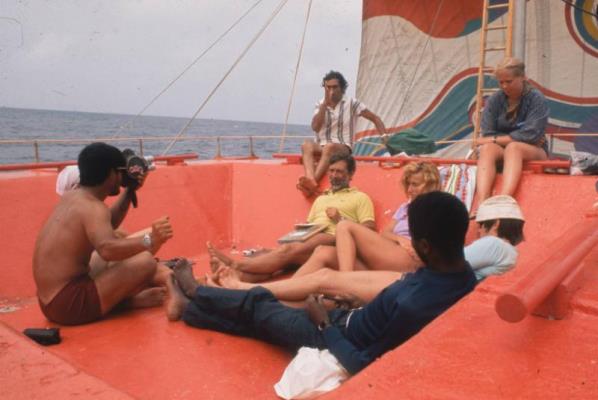
A scene from 1973 on the the Acali, with Santiago Genovés sitting in the center (Metrograph Pictures)
![]() This engrossing documentary starts off by recounting the hijacking of a 1972 commuter flight, which as fate would have it, included social anthropologist Santiago Genovés among its passengers. A scholar studying, of all things, the nature of human conflict, he was inspired to create a similarly high-stress environment, which he believed would help get at the heart of why people fight. Genovés eventually conceived of a long voyage across the Atlantic, wherein a small group of subjects would live together on a tiny, motorless vessel, with no means of turning back and, most importantly, no choice but to confront one another whenever tensions arose.
This engrossing documentary starts off by recounting the hijacking of a 1972 commuter flight, which as fate would have it, included social anthropologist Santiago Genovés among its passengers. A scholar studying, of all things, the nature of human conflict, he was inspired to create a similarly high-stress environment, which he believed would help get at the heart of why people fight. Genovés eventually conceived of a long voyage across the Atlantic, wherein a small group of subjects would live together on a tiny, motorless vessel, with no means of turning back and, most importantly, no choice but to confront one another whenever tensions arose.
The trip occurred one year later, and utilizing archived footage from the crossing, director Marcus Lindeen takes viewers back to the frenzy of publicity surrounding the experiment, which at the time seemed to offer hope to a world beset by war. The crew of the 12 x 7 meter raft, the Acali, became instant news celebrities. They included Maria Björnstam, a Swede as well as the first woman ever certified as a sea captain. She served as the commander of the Acali. She and the other young men and women, all of whom hailed from different countries and backgrounds, seem excited and upbeat, although that aura of optimism is disrupted early on by Björnstam’s boyfriend, who calls via shortwave radio to demand she stay behind.
The film constantly reminds us just how tiny and spartan the accommodations were. One shot reveals the crew in their sleeping quarters, where it seems as if everyone is more or less right up next to each other. The lack of privacy extends to the toilet, which is located right off the deck and within view of everyone, although interestingly, for some it served as the only place for peace. Clearly, Genovés was doing everything possible to generate tension: he also divided up all of the duties on board, and in a twist, gave women the more important roles, reserving menial tasks for the men.
As we get to know the crew members, it seems as though Genovés preferred women who were strong and independent. Besides Björnstam, the group included an African American woman, Fé, who was driven by a thirst for experience and knowledge; Servane, a trained scuba diver, who joined despite having a husband and children at home; and Edna, a danger-loving doctor from Israel, who, as it turns out, acted on her sexual urges despite the obvious constraints. Even Mary, an American who seems like the most low-key participant at first, has a secret past involving a daring life-or-death escape.
By contrast, the men recede further and further into the background as the women increasingly take center stage. “Will men be threatened and try to gradually take over?” was one of the questions Genovés hoped to answer. Ironically, the answer may have been yes, but only with respect to himself. Increasingly obsessed with trying to prove his hypotheses correct, he began to manipulate the others through lies and, in what comes across as an especially underhanded move, using the questionnaires they all filled out to sow divisions. He manages to emerge as an even greater existential threat than the ocean, yet to his credit, Lindeen avoids making this development seem from out of nowhere. Indeed, there are hints from as far back as the aforementioned hijacking recap that Genovés might be egocentric and lacking in empathy.
The Raft presents two story lines concurrently, each riveting in its own way. On the one hand, it re-creates the voyage itself, but it also repeatedly cuts to the present day, where those who took part and are still alive reunite on a rebuilt version of the Acali. Here, certain survivors get long-held feelings and secrets off of their chests. They also have a chance to compare notes about their experiences and even bond in ways they had been unable to back then as a result of Genovés’s machinations.
This is not to say there aren’t disagreements that crop up about exactly what happened more than 40 years ago. When Fé says that Genovés was a racist, another woman disagrees, claiming he never treated her in that way. But instead of an escalating war of words fueled by hot-blooded emotion, everyone has a rational discussion and acknowledges one another’s experience. Perhaps because they have all been through the same crucible and come out the other side, there is a mutual respect and understanding.
Genovés clearly wanted sexual entanglements to happen between his subjects, and he got that to some degree. However, in contrast to the media’s dismissive view of the entire enterprise, which certain outlets deemed “the Sex Raft,” in reality, the group was able to come together as an effective crew, surviving the voyage almost in spite of their host. There is some attempt to humanize Genovés toward the end, but his insights into his behavior are hardly insightful, as viewers will have already drawn the same conclusions.
By the time that the film finishes recalling the voyage, we certainly get the impression that it was a thrilling, life-changing adventure for those involved. If The Raft has flaws, they have to do with unanswered questions surrounding the participants, as the film never delves into what happened to the four non-surviving crew members. It never seems to strike Lindeen as curious that of those especially strapping male subjects Genovés sought out, three of the four are dead. Meanwhile, roughly three-quarters of the way through, a Japanese man who doubled as the ship’s photographer simply disappears without explanation. Admittedly, women have the more vital roles in the narrative, but as a survivor in a tale about survivors, it seems odd for him to just vanish.
Nevertheless, this is an intriguing, satisfying documentary about good intentions undermined by bad science, which still yielded a positive legacy, at least according to the film’s subjects.
Metrograph Pictures: THE RAFT [Official Trailer] from Metrograph Pictures on Vimeo.






Leave A Comment